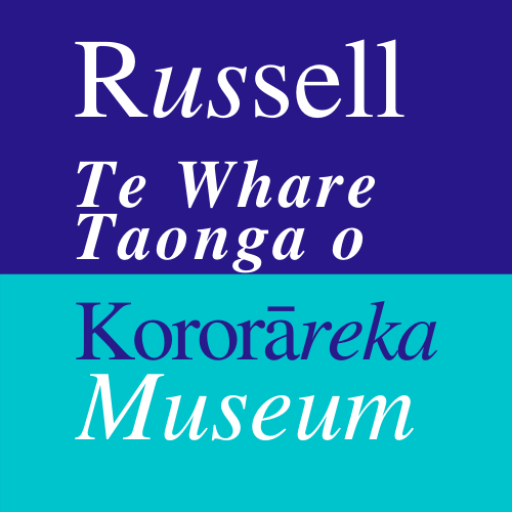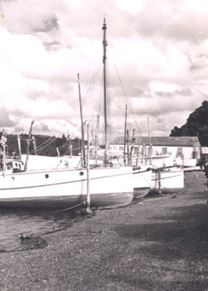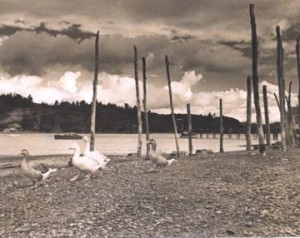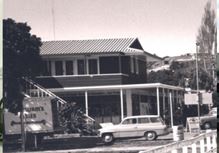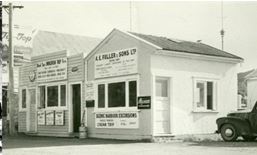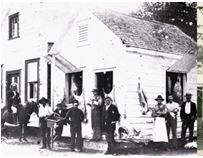What’s historic and what’s not? According to the Historic Places Trust register the Customhouse is but next door, the Duke’s not, even though its licence is. Just visible at the top of this photo on opposite sides of York St -Williams cottage is, but the Methodist Church is not. And south of the wharf The Gables is but our much photographed Four Square building is not. What do we keep? And what let go? This is a Tudor Collins photo, taken in 1947 when tennis and lawn bowls apparently figured large in locals’ priorities. There are only four or five cars but lots of dinghies. The line of pohutukawa along the shore is a testament to the large difference that one individual with energy and vision can make a to a small place. What will tomorrow’s images say about us?
Tag: heritage
-
The Transit of Venus and Rediscovery of New Zealand – #140
The month of June reminds me of Captain James Cook. Why? This same month in 1769, he observed the transit of Venus across the sun, in King George’s Land -Tahiti. Later the same year he reached Aotearoa -New Zealand. Britain at that time was a great world leader in astronomy. It would have cast dishonour upon them should the observations of this most important phenomenon be neglected. After all, this event was not due to occur again until 1874, more than 100 years later. It was decided that the transit be observed in three places, one of them being the Pacific Ocean. The Royal Society, after petitioning King George III, obtained funding to finance this adventure to the South Seas, a voyage expected to last perhaps two years, but which took almost three. A ship was purchased, The Earl of Pembroke, and renamed Endeavour – a bark of 368 tons, 97 feet length overall, 29 feet 3 inches beam. Cook was appointed commander and with a crew of 94, including young Joseph Banks as botanist along with his 7 servants and 2 greyhounds, Endeavour set sail on 26th August 1768, from Plymouth. Cook’s sailing instructions were to observe the transit of Venus then proceed to the southward in order to make discovery of the Great Southern Continent, “until you arrive in the latitude of 40 degrees”. Cook travelled via Spain, Portugal then around the bottom of South America to reach Tahiti in April 1769. He anchored in Matavai Bay, established Port Venus and observed the transit on 3rd June, then headed south. At about 2 o’clock in the afternoon of the 7th October Nicholas Young sighted Te Upoko o Te Kuri a Paoa, later known as Young Nick’s Head. His reward was a gallon of rum.
We are fortunate to have Ralph Sewell’s 1/5th scale model of Endeavour in the Russell Museum.
Photofile 18100. Endeavour model sailing with Ralph Sewell at the helm.
Source: Captain James Cook, a biography, by Richard Hough (1994)
-

Of Cats and Birds – #141
Here’s a tale for Gareth Morgan’s anti-cat file. In the Russell Museum we have on display a small bird called a Putopu. A member of the rail family, it is now extinct, but we have a remarkable story about the bird and how we came to have it in our collection. On March the 11th 1845, all residents of Kororāreka were to be evacuated by ship to Auckland, to escape the war raging in the town. A four year old girl, Catherine Flowerday, was gathering her possessions together when she realised her cat, Ginger, was missing. As the family were about to board the ship, Ginger came out of the raupo bordering a creek with a bird in his mouth. The family jumped aboard the longboat, cat, bird and all. The ship’s mate carefully removed the bird from the cat’s jaws. Unfortunately it was dead, but the mate was an amateur taxidermist, and as Catherine was leaving the ship in Auckland, he presented the bird to her in a glass case. Catherine kept the bird for the rest of her life. Years later the bird was donated to the Russell Museum by Catherine’s great-niece, Mrs Elsie Wilkinson, of Kamo. So come in and see the actual bird – one of the minor casualties of the Battle of Kororāreka. Come Back Ginger, a children’s story by Dorothy Butler based on the above incident, is available from the Russell Museum shop.
Sources: Come Back Ginger by Dorothy Butler; Hell-hole of the Pacific by Richard Wolfe.
-
Bye-bye Big Tree – #142
Big Tree – it’s an advertisement for benzine. You can only just make out the words on the roof of the wharf shed. They were on the other side too for a few years. This “new” Government wharf opened in 1927. Several years later Lord Bledisloe, Governor General from 1930 to 35, visited Russell. Bledisloe is remembered for gifting the Waitangi National Trust land, and the Bledisloe Cup, to the nation. He was also known for giving voice to his social conscience – at his own instigation, his salary was reduced by 30 per cent to match cuts in public servants’ salaries during the depression. He promoted his personal views too, successfully persuading newspapers to print full, unedited coverage of his speeches. According to museum records, while in Russell, he suggested to local authorities and the Harbour Board that the Big Tree advertising spoilt the aspect of such a historic place. It was painted out at once. Simple as that.
-

Our First Flag – Te Kara – #143
On certain dates you will see this flag flying from the Russell Museum and Maiki Hill flag staffs. It is Te Wakaminenga o Ngā Hapū o Nu Tireni – the Flag of the United Tribes of New Zealand.
In November 1830, with owners Patuone and Taonui on board, the Hokianga-built Sir George Murray was impounded in Sydney for sailing without a flag or register. A woven harakeke kaitaka, flown either from the stern or masthead of the ship, was not acceptable. New Zealand was independent then, not yet British, unlike the penal colony of New South Wales. In 1834 James Busby convened a gathering on his front lawn at Waitangi to choose a national flag. Twenty-five northern rangatira and a considerable number of followers attended. This flag was their choice. When the Treaty of Waitangi was signed in 1840 the Union Jack replaced it. Many Māori believed the United Tribes flag should have been flown alongside the Union Jack in recognition of their equal status with the government. Five years later Māori were at war with the Crown. The Union Jack was their first target. Over a century later, in 2009, hui were held throughout Aotearoa to select a national Māori flag. The Tino Rangatiratanga flag was selected and while it does not carry official status it is flown together with the New Zealand flag on days of national significance. Here in Kororāreka – Russell, we fly the United Tribes flag twelve times a year to commemorate significant events – twice more this year, on August 6th to commemorate the death of Hone Heke in 1850 and October 28th, when He Wakaputanga – The Declaration of Independence was signed in 1835.
Sources : www.nzhistory.net.nz; Ngāpuhi Speaks: Independent Report on Ngāpuhi Nui Tonu Claim; http://www.mch.govt.nz/nz-identity-heritage/flags/national-māori-flag
-
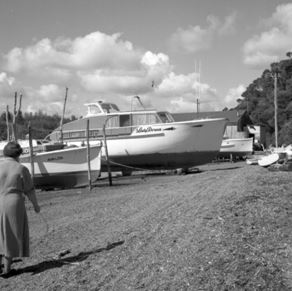
An Endangered Habit – #144
You’ll never see these sights again. They are part of our history. Kororāreka has long been a favoured location for re-fitting vessels, from whaleships to launches to racing yachts, but those days are almost over. Only one slipway remains in Matauwhi Bay today – at the Russell Boating Club. It’s been there since June 1979, the older mooring piles, slipways and cradles having been removed a year or so earlier. As with many changes, we can view the old ways with nostalgia while accepting the need for their demise. Hauling your boat out at high tide, scraping and painting it then slipping it back in again when the tide returns may be an endangered habit but it’s all in a good cause – the protection and enhancement of our marine environment. L to R Photofile #s: 4502, Hanlon C35, 4506.
-

Quiet and Unhurried – #145
Two men, two dogs and a sunny spot out of the wind on the Russell wharf. If he’d been there, my Dad might have said “I wouldn’t call the King my Uncle.” He used to come out with that whenever he was feeling especially content with his lot. These two would have understood I’m sure.
As we try to come up with a future plan for this special place where we have chosen to live perhaps we could give a little thought to the words of Marie King. She lived here most of her life, was first curator of Russell Museum and author of two books on Russell. In her first book, Port in the North, published by the Russell Centennial Historical Committee in 1948, she said:
Kororāreka, the scene of battle, murder and sudden death, and robbery under arms – that is all past and almost forgotten. There remains Russell, quiet and unhurried…There are not a few who insist that Russell’s lack of hurry and bustle is its chief charm, quoting W.H. Davies’ poem “Leisure” to prove their point. “What is this life if full of care/We have no time to stand and stare?/No time to stand beneath the boughs/And stare as long as sheep and cows?/No time to turn at Beauty’s glance/And watch her feet how they can dance/ A poor life this if full of care/We have no time to stand and stare?
-
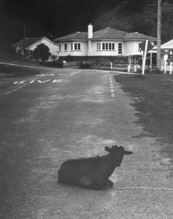
Livestock in the Streets – #146
It’s Russell in the 1970s – Claude Conning’s goat rests on the road while sheep silently mow the church fence line. In the centre, cows wander along York Street in 1915. Images like these feature in Russell Museum’s upcoming exhibition – Look Twice – documenting the trajectory of change in our town by juxtaposing historic and modern photographs of the same scenes. Opening night: Oct 11th.
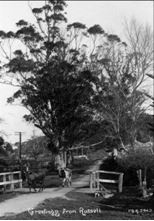
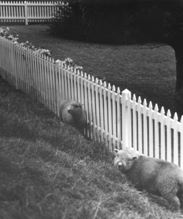
-

Invasion menace – Russell Saved – #147
The ships were here as part of combined Australian – Dominion fleet manoeuvres. The Kiwi ships were HMS Diomede and HMS Dunedin and the visiting warships, HMAS Canberra and HMAS Australia. Our air force had a presence too – that’s the amphibian just off the wharf. They were all engaged in a mock attack on Russell with the Canberra attacking and the other three defending. Headlines announced ‘Raider Outwitted. Repulsed by Defenders. Lurking Foe At Sea. Invasion Menace. Russell Saved.’ Following the exercise the crews indulged in more light-hearted pursuits. There were boat races, both rowing and sailing, and football matches on the domain followed by a Russell Bowling Club dance at the Town Hall where, according to the Northern Advocate report, the HMS Dunedin’s band ‘rendered delightful music’ and ‘total takings amounted to £9’. The next day the fleet left for Auckland carrying out exercises en route, including the firing of two torpedoes and two hours gunnery practice. The date was August, 1933.
-
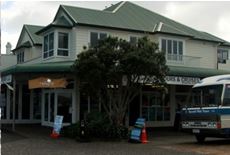
From Horses to Buses – Changes On The Corner – #148
We didn’t have room on the ‘Look Twice’ exhibition wall for these images but they are too good to leave unseen – so here’s a chance to look four times at the corner of Cass St and The Strand. On the left we have T.R.Williams and at least two of his brothers in front of his butchery c. 1910 – W.J.Williams is seated on a horse. Moving right, and onwards in time we come to A.E. Fuller & Sons Ltd. Russell office c. 1950s. Next, the same office in a new building c.1970s and on the extreme right we are in the present, 2013.
